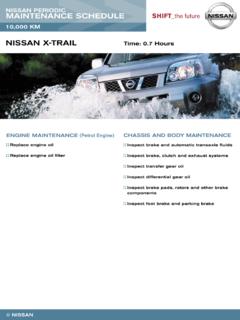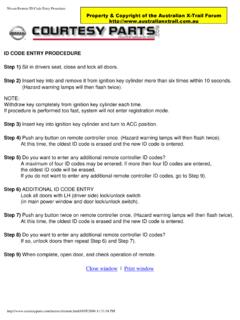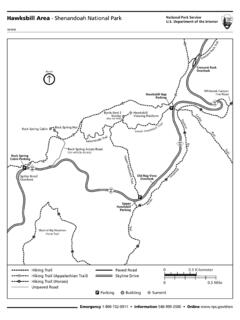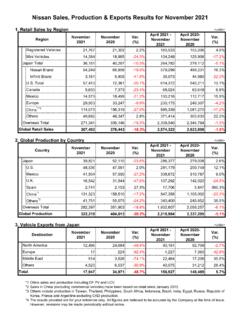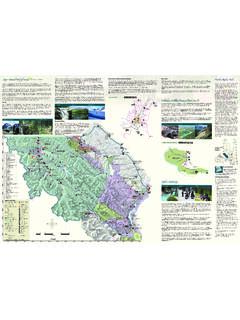Transcription of AutoSpeed - Nissan's New Engineering - AUSTRALIAN X …
1 Nissan's New EngineeringThe story behind the Julian EdgarTake a look at these specs and picture the car: Four wheel ventilated discs with twinspot front calipers, ABS, brake assistand electronic load proportioning four cylinder with balanceshafts, electronic throttle, variable valvetiming, variable intake manifold anddirect fire ignition - 132kW. Front MacPherson struts with forgedalloy lower arms and rear parallel linkrear struts Electronically-controlled active fourwheel driveThinking along something exotic - perhapsEuropean? Surely, a performance car? AutoSpeed - Nissan's New Engineering1 Well, our pics give it away but if you hadn'tworked it out, these are the specs of the humbleNissan X- trail !However, it's a dead-set certainty that many ofthese components will find their way into thecoming range of small nissan performance all, you don't replace both the SR 2-litreand KA engines with a new design andthen use it sparingly!
2 Yes, this engine, - andperhaps the four-wheel driveline - spell outNissan four cylinder performance after the end ofthe famous SR20 the good news is that the wonderfulQR25DE engine is one that can follow in thesteps of the L-series and SR-series, with its headheld high. Apparently there's no turbo versionyet, but even the NA engine is a superb fourcylinder - torquey, powerful, smooth and New EngineThe QR engine series was specifically developedby nissan engineers to replace both thefree-revving SR20DE and the torquier KA24 DEengines. To fill these roles it had to be bothdriveable and also develop sufficient engineers had five main criteria to meet: Quietness - large swept volume fourcylinder engines usually have high noiseand vibration; the QR engine designsaimed for near six-cylinder refinement.
3 High Performance - an engine that willbe used across a wide range of carsrequires good bottom end the nissan engineers state, "Outputtorque at low to medium engine speedsis the most important contributor todriving pleasure in daily use." Low Fuel Consumption - an aim thatthese days that applies to all new enginedesigns. Lightweight and Compact - since it willbe fitted in small, medium and largevehicles, the engine must be sized sothat it can be packaged as required Parts Count Reduction - this results in alighter, more compact engine that ischeaper to QR series of engines is - at the time ofwriting - available in four - Nissan's New Engineering2 NameQR20 DDQR20 DEQR25 DDQR25 DETypeWater-cooled, gasoline, 4-cycleDisplacement (cc)19982488 Arrangement and No. of cylindersInline 4-cylinderType of combustion chamberCross-flow, pentroofValve mechanismChain-drive DOHC with 4 valves/cylinderFuel systemDirect injectionPort injectionDirect injectionPort injectionBore x stroke (mm) x x :1 Valve head diameter (mm)Intake: ; Exhaust: bore pitch (mm) pin-journal diameter (mm) main-journal diameter (mm) rod length (mm) 'DD' engines are direct injection, while the'DE' engines are conventional port injection.
4 Ascan be seen, the larger versions aremade by simply stroking the 2-litre; bore sizeremains the same at 89mm. This makes the engine a very long stroke design -interesting, since the SR20 is 'square' (ie hasidentical bore and stroke dimensions). However,the QR25DE revs quite sweetly to its 6500 rpmcut, with peak power developed at 6000 - Nissan's New Engineering3To smooth the inherent vibrations in a big four,the QR-series use a patented twin balance shaftsystem. The shafts are located in the sump,driven by a chain from the crankshaft at twiceengine speed. The balancing rate was determinedby measuring vibration at the front right-handengine mount, which apparently was the mostcritical in producing booming QR series engines use lightweight, die-castalloy blocks. Unlike the previous sand castingapproach taken with both the SR and KA-seriesof engines, die-casting allows thinner wallsections.
5 However, only open-deck block designscan be produced using this approach, so theclosed-deck designs of the older engines addition to the weight reduction resultingfrom the casting technique, the QR series ofengines have reduced mass over the previousdesigns by the use of a resin rocker cover, resinintake manifolds (some models only), stainlesssteel tubular exhaust manifold, and a serpentinebelt drive of the accessories. Compared with theSR20, the QR20 at 110kg weighs approximately10kg less, while the QR25 weighs about 20kgless than the superseded KA24. The QR20 isalso 30mm shorter than the with other nissan engines, the internals are toa very high quality. The crankshaft is forged forstrength and micropolished to reduce crankcase is split along the crankshaftcentreline, with the lower half of the five mainbearings supported by the bottom half of thecrankcase.
6 This section is termed by nissan aladderframe, although it is quite different to thesimilarly named item used in the RB-seriesengines where a ladder structure containing thelower half of the main bearing caps is bolted intoplace. The main bearing caps are made fromeither iron and aluminium - number 1, 3, and 5main bearing caps are iron, while number 2 and4 are aluminium. Aluminium is used in thosecaps which have only a small effect on - Nissan's New Engineering4 The QR series uses chain drive for the camshafts- belts seem to be going out of fashion. A newdesign 'silent chain' is used - it has a pitch ( ), allowing a narrow includedangle between the intake and exhaust valve and acompact combustion chamber shape. Thevalvetrain uses a direct-acting cam-on-bucketdesign, with valve clearances set via 26lifter-crown-thickness it's notexpected that these will need to be changed whilethe engine is in intake camshaft timing can be varied toprovide an overlap from 3 to 33 degrees.
7 Thestepless variable camshaft control uses a helicalgear in the end of the intake cam, altered in itsposition by solenoid-controlled oil and medium engine speed torque isimproved by the system, while pumping lossesand oxides of nitrogen emissions are alsoreduced by the use of a greater valve overlapunder partial load conditions (ie, internal EGR).The intake manifold is of a variable design, withdual-length parallel runners provided for eachintake. Up until a high 5000 rpm, the shortrunners are blocked by a butterfly valve - abovethat engine speed they open, whereupon bothintake runners can supply air. The intake air isregulated by an electronic throttle butterfly, sothe relationship between the accelerator positionand the actual throttle blade opening isn't practice, this simply helps make the enginefeel more responsive and - Nissan's New Engineering5To improve resistance to detonation, extensiveresearch was undertaken in the area of enginecooling.
8 The water flow within the engine wasanalysed by computer simulation, and thevelocity of the water was increased by 44 percent over the base model. Cooling around thespark plug was improved by the use of along-reach plug, which allowed the water jacketnear the valve seats to be cooling system is also two-stage. Under"normal operating conditions" the flow ofcooling water to the cylinder block is closed off,raising the temperature of the bores and soreducing friction. However, when the watertemperature reaches 95 degrees C, the valveopens to allow flow through the DrivelineThe X- trail uses an electronic four-wheel drivesystem that owes more than just a hint of itsdesign to the original ground-breaking SkylineGT-R system. Like the GT-R, it uses a wetmulti-plate clutch to vary the torque splitbetween the front and rear wheels, however, inthe Skyline, the driveline was predominantlyrear-wheel drive with torque directed frontwardsonly as necessary.
9 In the X- trail the oppositeapplies - the car is predominantly front-wheeldrive, with torque directed rearwards as diagram shows the layout. A transfer caseturns the drive through 90 degrees, sending italong a propeller shaft to the rear diff. In theextended nose of this differential assembly is awet multiplate clutch ('coupling') that apportionstorque to the rear wheels. With the couplingunlocked, no torque turns the rear wheels - thecar is pure front-wheel drive. With the couplingfully locked, the front/rear drive is 57:43, a ratiodetermined by the transfer case. Thus thegreatest amount of torque that can be directedthrough the rear wheels is 43 per - Nissan's New Engineering6 The electronic control system uses inputs fromthe accelerator opening (not throttle opening -that doesn't vary in its opening angle linearlywith the accelerator, remember!)
10 And enginespeed. Additionally, an accelerometer (g-sensor)inputs its signal into the control unit. It's notcompletely clear from nissan literature, but weassume that the g-sensor measures longitudinalacceleration, as its input is also used by the ABSpart of the wet multiplate clutch locks proportionallywith the current that is sent to it by the purely mechanical systems used in someother mid-size four-wheel drives, the electronicsystem has the advantage in that it can predictwhen four-wheel drive will be needed - it can beproactive rather than simply react to frontwheelspin. Driver selection of differentfour-wheel drive modes is also made from a performance point of view thistype of system is limited by the transfer casegearing in the proportion of torque that can besent to the back wheels, the electronicadjustability does give it some distinctadvantages over a viscous coupling system.
